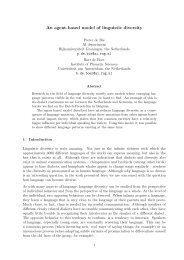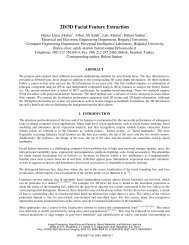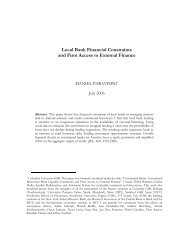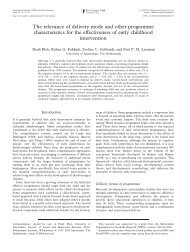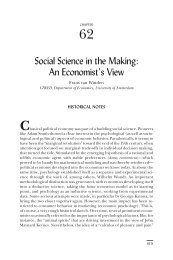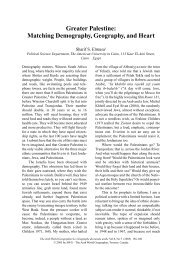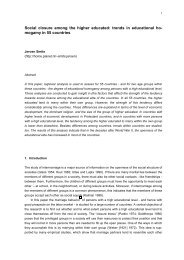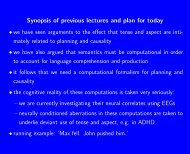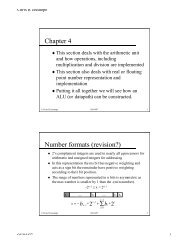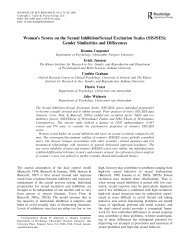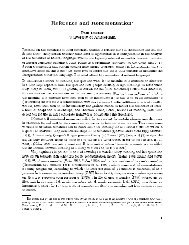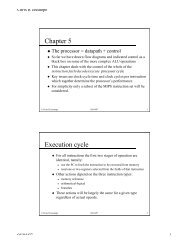Loop models
Loop models
Loop models
You also want an ePaper? Increase the reach of your titles
YUMPU automatically turns print PDFs into web optimized ePapers that Google loves.
<strong>Loop</strong> <strong>models</strong>Bernard Nienhuis, les Houches 2008Updated: July 16, 20081 Historical perspective<strong>Loop</strong> <strong>models</strong> have come up in the theory of phase transitions and (other) criticalphenomena. One may say that the best understanding of phase transitions has comefrom a succession of theories through the 20-th century. It started with Mean Field(MF) theory, which was the dominant theory until Renormalization Group (RG)took over around 1970. Much of the research began to be done in two dimensions,for two reasons. It is much easier to do numerical calculations in 2D than in 3D,and many of the critical exponents appeared to be rational (giving more hope tocalculate them or even guess them). In 2D the Coulomb Gas (CG) method provedto be an effective way to calculate universal quantities. It is largely formulated inthe language of loop <strong>models</strong>. Very many lattice <strong>models</strong> can be represented as loop<strong>models</strong>.The notion that conformal invariance is both plausible and powerful led to thestudy of Conformal Field Theory (CFT) as the scaling limit of critical systems.It proved very effective in predicting many properties of the scaling limit. Finallyaround 2000 the Stochastic Löwner evolutions (SLE) allowed the mathematiciansto prove what physicist had been so busy calculating all these years. While CFT,and (in its specialization of rigor) SLE are currently more powerful than CG, thelatter approach is unique in that it makes direct contact with the (lattice) modeland with the specific operator under investigation.In parallel to all of these ran a series of exact solutions (e.g. partition sums) ofspecific <strong>models</strong>. The 2D Ising model had already shed doubt on the validity of MFtheory in 1944. Much later followed the 6-vertex model, and the 8-vertex model.The hard square and hard hexagon model. In particular the formulation of the YangBaxter equation (YBE) led to an explosion of solvable <strong>models</strong>.2 Brief summary of renormalization theoryThe ideas that led to the application of renormalization (usually designated RenormalizationGroup, or RG), to condensed matter systems can be formulated as follows.A many body system can have a number of relevant spatial scales. Themicroscopic scale is e.g. the size of the molecules or the lattice constant (in casethe lattice is considered as given). Emerging length scales are correlation lengths.In generic systems these various length scales are of the same order of magnitude.However, when a continuous phase transition (or critical point) is approached thecorrelation lengths grow, and can become macroscopic. This implies that macroscopicproperties involving space have a characteristic scale. However, when thecritical point is reached, this scale diverges. Therefore the characteristic scale disappears,and the observables become scale invariant (that is for scales sufficientlyremoved from the microscopic scales). If this is taken seriously then it is plausiblethat one can formulate a scale transformation for which the critical system is invariantand the generic system covariant. The possible existence of such transformationhas already some important consequences that can be verified. If the transformationcan be calculated or approximated more can be deduced.To make this explicit consider a large but finite statistical system with N degreesof freedom s, associated with the sites of a lattice. It has a hamiltonian H N (g, s),where g stands for a number of coupling constants. The partition sum (or integral)is given byZ N (g) = ∑ e −HN (g,s) (1)s(the factor kT is absorbed in the coupling constants). To formulate a renormalizationtransformation (RT) we assume that we can course grain the variables toa smaller number, say N ′ . This means we do the summation as far as the localsmall wavelength variables is concerned, so that the sum over the remaining variableswould result in the original partition sum. The summand after the partialsummation is written as an effective Boltzmann weight again, so thatZ N (g) = ∑ se −HN (g,s) = ∑ s ′ e −H N ′ (g′ ,s ′) = Z N ′(g ′ ) (2)The notation reflects the hope that the effective Hamiltonian of the smaller systemis of the same form as the original Hamiltonian but with altered values of thecoupling constants. We further assume that the function g ′ (g) is analytic or at leastdifferentiable even at a phase transition. There is no need to assume that one knowshow to do this, only that in principle it can be done.Let N = l d N ′ , with d the dimension of space, so that the linear change of scaleis l. In the limit that N is very large the free energy is proportional to N, so thatthe free energy per lattice site satisfiesf[g ′ (g)] = l d f(g) (3)Going back to the correlation lengths, we introduce the symbol ξ for one of thecorrelation lengths, in units of the lattice constant. This must satisfyξ(g) = lξ[g ′ (g)] . (4)This equation tells us that criticality at g implies criticality at g ′ (g). Thereforecritical manifolds are invariant under the map g ′ (g). We may then assume that acritical manifold contains fixed points.which are going to play a leading role.g ′ (g ∗ ) = g ∗ , (5)Exercise: (1) Argue why limit cycles are not to be expected in these transformations. (2)What can one conclude concerning the value of ξ at a fixed point.12
If the microscopic scale is not given by a lattice, but by a (UV) integrationcut-off, it is more convenient to take l as a variable, and analyseβ(g) ≡ liml→1∂g ′ (g)∂lcalled the β-function. In this case the equation for the fixed point is β(g ∗ ) = 0.What can we say about the behavior of the system in the vicinity of a fixedpoint? Sufficiently near g ∗ we can linearize the transformation, and diagonalize thederivative matrix ∂g ′ (g)/∂g. The principle variations of g near g ∗ we call u j , and wecan write the free energy and correlation length in terms of these u j . The significanceof a specific u j depends on the corresponding eigenvalue. If an eigenvalue (assumedto be real) is larger than unity, the corresponding u j grows, and if it is less than 1,u j decreases.Since the eigenvalues are not independent on l, it is useful to make that dependenceexplicit. Since successive RT’s with rescaling factors l and l ′ correspondto a rescaling with factor l l ′ , and also the eigenvalues multiply, we write theseeigenvalues in the form l y .To illustrate the distinction of eigenvalues larger or less than one, or positiveand negative exponent y, we first discuss a case with two coupling constants, andy 2 < 0 < y 1 . Considering the ’flow lines’ (i.e. the curves in the parameter spacetraced out by repeated renormalization), suggests/shows that the phase transitionis at the line u 1 = 0, as that is the watershed between different limits of the flows.If e.g. the effective variables at a very coarse scale are strongly coupled, the originalvariables will have long ranged correlations, and if the effective variables are weaklycoupled, the original variables have only short range correlations.The functions ξ(u 1 , u 2 ) and f(u 1 , u 2 ) satisfyξ(u 1 , u 2 ) = lξ (u 1 l y1 , u 2 l y2 ) and f(u 1 , u 2 ) = l −d f (u 1 l y1 , u 2 l y2 ) (7)the solutions of these equation are given byξ(u 1 , u 2 ) = |u 1 | −1/y1 X ±(u2 |u 1 | −y2/y1) , f(u 1 , u 2 ) = |u 1 | d/y1 S ±(u2 |u 1 | −y2/y1) ,(8)where X and S are unknown functions, and their suffix is the sign of u 1 . Since thelocus of the transition is u 1 = 0, nothing special happens at u 2 = 0. This impliesthat the thermodynamic functions are analytic at u 2 = 0. Therefore the functionsX and S can be expanded in their argument.∞∑∞∑ξ(u 1 , u 2 ) = X k,± u k 2 |u 1| (−1−k y2)/y1 and f(u 1 , u 2 ) = S k,± u k 2 |u (d−k y2)/y11|k=0(9)We see here that the singular behavior of the free energy and the correlation lengthare a sum of power-law terms, with increasing exponent. The non-integer powersconcern the u 1 dependence. The leading term is determined by y 1 . None of theexponents depends on the value of u 1 or u 2 . Because the leading critical behavior isnot affected by u 2 , this parameter is called irrelevant. In contrast, the parameterswith positive exponent y are called relevant. When y = 0 the correspondingparameter (or operator) is called marginal.3k=0(6)Exercise:Exercise:Argue that a marginal operator can be marginally relevant, marginally irrelevant,that this behavior will generally be different on either side of the fixedpoint, but need not be, and finally that one can also have strictly marginaloperators.The amplitudes of the non-dominant terms depend explicitly on the value of theirrelevant parameter. When the nonlinear terms of g ′ (g) are taken into account,also the coefficient of the leading term will depend on u 2 . Finally, note that theexponents of the free energy and of the correlation length are not independent.Now consider a case with two relevant variables, y 1 > y 2 > 0, omitting possibleirrelevant variables. To make contact with some real life case, think of u 1 as themagnetic field, and of u 2 as the temperature variation with respect to the criticaltemperature. Equation (9) for the free energy can be used to calculate the variousthermodynamic functions: magnetization M and susceptibility χ as first and secondderivative of f w.r.t. the field h, the heat capacity C as second derivative of f w.r.t.the temperature T . The well-known critical exponents (at zero field: C ∝ |T −T c | −α ,M ∝ (T c − T ) β , χ ∝ |T − T c | −γ , ξ ∝ |T − T c | −ν , and at T = T c : h ∝ M δ ) can nowreadily be calculated readily. We get:α = 2 − d y 2, β = d − y 1y 2, γ = 2y 1 − dy 2, δ = y 1d − y 1, ν = 1 y 2(10)Verify these values of the critical exponents.Evidently these exponents are not independent but can expressed in ony twovariables.Also the overall scaling of critical correlation functions can be calculated withinthe RG framework. Let the (extensive) operator conjugate to one of the parametersu j be Q j . Now consider the fluctuation of Q j in a finite system with linear size L,away from the fixed point only along the u j -axis:This scales asso thatG(u j , L) ≡ 〈Q j Q j 〉 − 〈Q j 〉 2 = L d ∂2 f L (u j )∂u 2 j(11)G(u j , L) = l 2yj G(l yj u j , L/l) (12)G(0, L) ∝ L 2yj (13)Let Q j be written as a sum (or integral) over local operators:∫Q j = d d r q j (r) (14)L dthen G can be written as an integral over the two-point function of q j (r):∫ ∫Q j (0, L) = d d r d d r ′ 〈 q j (r) q j (r ′ ) 〉 − 〈 q j (r) 〉 〈 q j (r ′ ) 〉 (15)L d L dThis leads to a power law decay as〈 q j (0) q j (r) 〉 − 〈 q j (0) 〉 〈 q j (r) 〉 ∝ |r| 2(yj−d) . (16)It is convenient to introduce x j = d − y j . Note that also irrelevant operators have apower law decay for their two-point function, but these decay faster than |r| −2d .4
Exercise: Consider a fixed point with only irrelevant parameters. All y j are negative.Can you think of any further restriction on the possible values of these y j ?2.1 SummaryThe existence of an RT is a strong and unproven assumption. It has the followingconsequences:on the square lattice, or like• Relevant and irrelevant parameters (y > < 0) increase and decrease under(repeated) renormalization.• Critical exponents and scaling functions do not depend on irrelevant parameters,but can only depend on invariants of the RT, e.g. symmetry and spatialdimension. In particular, they do not depend on the lattice. This claim isknown as universality.• Two-point functions decay with a power of the distance equal to2x j = 2(d − y j ), where y j is the exponent of the coupling parameter conjugateto the operators correlated.• All correlation lengths diverge with the same exponent, as a critical point isapproached.• Critical exponents are independent on the side from which the critical pointis approached, but the corresponding amplitides are independent.• Critical amplitudes and corrections to scaling do depend on the irrelevantparameters.• The exponents for the various thermodynamic quantities are not independent,but satisfy a number of scaling relations.• When integer linear combinations of the exponents y add up to d, correspondinginteger power laws are modified with a logarithm.• RG admits the existence of a line of fixed points, along which critical exponentsmay vary.• At the point where an irrelevant parameter turns relevant, there are logarithmiccorrections to the power law behavior.In all cases where exact solutions of model systems or accurate experimental ornumerical data are available, (and these are many), these consequences (and more)of the RG are corroborated. For physics this is the ultimate test of a theory.3 <strong>Loop</strong> <strong>models</strong>We will discuss lattice gases of non-intersecting loops (polygons) on the lattice. Thelocal configurations of these <strong>models</strong> can look like (up to rotations):5Exercise:Exercise:on the hexagonal lattice. The different local configurations on the square lattice,have weight 1, u, v and w, respectively and on the hexagonal lattice 1, and x. Eachclosed loop has weight n. The n=0 loop model denotes not just the n → 0 limit,which is trivial, but the derivative of the partition sum w.r.t. n, which generatesthe configurations of a single loop. One may also take higher derivatives to describethe interaction between a fixed number of such loops.Verify that the loop model for generic n is not local in the sense that a localchange in the configuration changes the weight in a way that can not be determinedby local inspection near the locus of the change. For what value(s) of nshould one make an exception?Show that the hexagonal version can be recovered from the square by allowingthe weights to be non-isotropic, and demanding that the weight on the squarefacorizes into two triangles.It is natural to make a distinction in the loop weights between contractibleand non-contractible loops, and between true loops and paths that terminate on aboundary.Similar <strong>models</strong> on the triangular lattice or more general semi-regular or evenrandom lattices can be readily formulated. Also intersections, or loops in differentcolors can be introduced, or additional variables decorating the loops. These alsohave various ’applications’ and have been studied. Here we consider only the simplestversions.The configurations shown need not all have positive weight. If the first three(for the square lattice) have zero weight, every edge is covered. This model will bereferred to as Completely Packed <strong>Loop</strong> (CPL) model. If only the first and the lastare omitted, every vertex is visited once: the Fully Packed loop (FPL) model. Thisalso has a hexagonal version by taking only the second of the hexagonal vertices.When all vertices have non-zero weight (on the square or hexagonal lattice), onecan still control the density of loops by the weight of each vertex configuration.The model has a non-critical phase for small step fugacity, then a continuous phasetransition at into a critical phase for large step fugacity. At the phase transitionthe model is sometimes called the dilute loop model, and in the large step-fugacityphase the dense loop model.These <strong>models</strong> have universal critical behavior (i.e. depending on n only) whenthe loop weight is −2 ≤ n ≤ 2. They also have other critical points but these are6
induced by frustration due to the specific lattice structure, and are therefore notuniversal in the traditional sense of independence of the lattice.3.1 ADE <strong>models</strong>As explained in Cardy’s lecture these loop <strong>models</strong> can be used to represent ADE<strong>models</strong>. These are <strong>models</strong> in which the faces of the lattice assume discrete states,represented by the nodes on a graph G, with links between states that are allowedto be adjacent. The name ADE <strong>models</strong> comes from the classification of graphswith largest eigenvalue less than 2. These are the A m series (an open linear graphwith m nodes), the D m series (one branch pont with three legs with respectively 1,1, and m-3 edges), and the exceptional E m diagrams with m ∈ {6, 7, 8} (again athree-legged diagram with 1, 2 and m-4 edges respectively).The adjacency matrix of the graph is called A i,j . (A i,j is one if the nodes i andj are connected and zero otherwise) The weight of the ADE model is completelylocal, and written as a product over the vertices:W ADE = ∏W (k) ∏vert kturnsA ij(SjS i) γb/2π. (17)There is a factor W (k) for each vertex depending only on the local configuration ofdomain walls, and a factor for each turn of the domain wall which also depends onthe states of the faces on the inside (j) and outside (i) of the loop. The bendingangles γ b are counted positive where the loop bends inwards, so that the sum of thebending angles along a loop is +2π. Thus the weight of an entire closed domainwall isW loop = A j,kS kS j, (18)and thus depends on the state k∑inside and j outside the domain wall. We now chooseS j to be an eigenvector of A:j A i,jS j = S i . If we choose the Perron-Frobenius(PF) eigenvector with only positive elements, then the local weights are real andpositive. When for a fixed configuration of domain walls the sum over compatiblestate configurations is performed, each closed domain will thus contributes a factorequal to the eigenvalue of A, i.e. n, just as in the loop model. This works perfect ona singly connected bounded domain with all the boundary sites in the same state.With other boundary conditions the paths may terminate on the boundary, andthese paths may have a weight different from n.On a torus, however, there may be non-contractible loops, which do not havethe weight A j,k S k /S j , but simply A j,k . The domains separated by these windingloops form a closed chain. Once all contractible domains are summed over, the onlysum that remains is over the non-contractible domains. This sum is a trace over apower of the matrix A. The ADE partition sum on the torus therefore reads,Z ADE,T = ∑ ∑ ∏W k n Nc Λ Nwj (19)jcfg vertices kwhere the first sum is over the eigenvalues of A, the second over all loop configurations,and N c is the number of contractible loops, and N w of winding loops. When7Exercise:N w = 0, the sum on j is simply the sum over the states of the outermost domain.Each term in the sum on j corresponds a sector of the Transfer Matrix, and to acharacter in the conformal partition sum.The other eigenvalues can also be used as a possible value for n. In this case theADE model may have complex weights, but this is not necessarily the case. Themodel will have negative dimensions, which can be a blessing or a curse. It may beavoided by some selection rule that excludes the negative weight sectors (i.e. thesectors with eigenvalue > n).3.1.1 ABF <strong>models</strong>The <strong>models</strong> with adjacency diagram A m have been studied by Andrews, Baxter andForrester, and are called ABF <strong>models</strong> the restricted solid-on-solid (RSOS) model. Itcan be viewed as a spin-(m-1)/2 Ising model. Since the Boltzmann weights dependon the position on the diagram, the model has a parameter space that increaseswith m. The specific critical point that is obtained from the prescription describedabove, and based on the CPL model, is not the Ising critical point, except for m=3.For increasing m it gives a sequence of multicritical points, each one selecting thepoint in parameter space where the previous one turns first-order. The same is truefor the general loop <strong>models</strong> in the dense phase. In the dilute loop <strong>models</strong> the samesequence of universality classes is found, with m shifted down with one unit.Calculate the loop weights n for the ABF <strong>models</strong>. Note that the loop weight forthe Ising critical point (or the points in universality class of the Ising criticalpoint) can take two values. How are they related to SLE?3.1.2 The A ∞ modelThe A m <strong>models</strong> in the limit m → ∞ will play an important role in these lectures,since they are the basis for the Coulomb Gas (CG) theory. The position along thediagramm is sometimes referred to as height, and the model named height-model.They have a continuous spectrum of eigenvalues −2 ≤ Λ ≤ 2, which makes themvery flexible. Also they have running wave modes as eigenstates, so that the elementsof the eigenvector are all the same in magnitude, only different in phase. We willuse them mainly as a calculational tool: they admit any possible loop weight in theinterval [-2,2], and the operators in other <strong>models</strong> can usually be translated in theA ∞ language.Only for n = 2 the A ∞ has (positive) real weights, and can be used to describethe behavior of a crystal surface. Each height representing a stack of atoms withrespect to some reference position. The non-critical phase is called smooth, referringto the fact that all the heights globaly concentrate around one given value (symmetrybreaking of the Z symmetry). The regions of other heights form small islands or(lakes) and occasionally islands within islands.The dense phase is called rough, because here the heights fluctuate wildly, thelocal averages of heights take continous values, and the system (on a large scale) nolonger has preference for integer values. The transition between the smooth and therough phase is called the roughening transition. It is interesting to note that in realcrystal the roughening temperature depends on the direction in which the height is8
Exercise:Exercise:Exercise:Verify that this Hard Hexagon model can be obtained from the CPL model inwhich the weights (up to a sign) have the same ratio as the elements of theeigenvector of the A 4 diagram (i.e. the golden mean ( √ 5+1)/2). One neednot take the PF eigenvector. To get full hexagonal symmetry, the two sitesacross one diagonal may not be occupied at the same time, and the two sitesacross the other diagonal must not interact.Motivate that the Hard Hexagon model must have the same critical exponentsas the three-state Potts model.3.2 The O(n)modelAnother representation of the loop model on the hexagonal model, is the O(n)<strong>models</strong>with∫Z O(n) = Ds〈j,k〉(1 ∏ + xs j · s k ) (20)The n-component spins sit on the vertices of the hexagonal lattice, and the interactionfactors are between nearest neighbors. The name O(n)model, I derived fromthe global O(n)symmetry under which the measure is invariant. The single spinmeasure and the spin length are normalized such that ∫ Ds = 1, and ∫ Ds s · s = n.The loop model is obtained as the expansion of Z O(n) in powers of x: The productunder the integral is expanded, and the second term in the binomial is indicated asa bond on the corresponding lattice link. The only terms in that expansion thatsurvive the integration over the spins have an even number of bonds incident ineach lattice sites. The spin integration involves a sum over spin components, whichresults in a factor n per loop.Show that the square loop model can be obtained by O(n)spins on the verticesof the 4-8 lattice (a lattice with coordination number 3, where, at each vertextwo, octagonal and one square face meet)Ordinarily one is interested in the critical behavior of the ordinary n-componentHeisenberg model:⎛ ⎞∫Ds exp Ks j · s k⎠ (21)⎝ ∑ 〈j,k〉on any lattice. Universality would in principle assert that this model, having thesame O(n)symmetry, has the same critical behavior as (20), but let us look criticallyat the difference between the two <strong>models</strong>.By expanding the exponent in(3.2) one gets multiply occupied bonds (powers ofKs j · s k ). One then has to sum over all ways to connect the elementary steps of thediagrams pairwise in each vertex. (see exercise below) Every closed polygon acquiresa weight n by the summation over the indices. By the mutiple occupancy of thebonds, and also for singly occupied bonds on a four- or more-coordinated lattice,the polygons may cross each other as well as themselves. Thus the main differencesare (i) multiply occupied bonds, and (ii) intersections.Let us take the premise that the model (20) is exceptional in its critical behavior.This implies that it is a fixed point in a larger parameter space, and the deviation11Exercise:from it is relevant. This means that such positive deviation will grow, but if it iszero it remains so.When one looks at the graphs of both <strong>models</strong> (20) and (3.2) from a big distance,multiply occupied bonds can not be distinguished from neighboring parallel edges,each of which is singly occupied. This suggests that under RT multiply occupiedbonds will be generated. This inconsistent with the premise that these multiplyoccupied bonds contribute to a relevant perturbation.Thus loops seen on a great distance may begin to touch each other. However, theywill not be seen to intersect, if they did not intersect to begin with. This suggeststhat intersections can not be generated by an RT, and therefore a model withoutintersections may well be a fixed point in the space of <strong>models</strong> where intersectionsare allowed. The non-intersecting loop model will be generic if the intersections areirrelevant, and exceptional if intersections are relevant. This will have to be verified.Consider the O(n)spin model (20) on the square lattice, and find the set ofpossible diagrams in the formal expansion of Z in powers of x, and the prescriptionfor the weight of these diagrams.3.2.1 Models with Cubic symmetryThe cubic symmetry in this context denotes the symmetry group of the n-dimensionalhypercube. The spins can be discrete and point say to the vertices of thecube, or to the hyperfaces of the cube (i.e. the vertices of the hyper-octahedron),but they can also be continuous, and have a weight function with cubic rather thanO(n)symmetry. As long as the partition sum is defined as in (20) (with the spinmeasureadjusted), the small-x expansion is again the loop model.Another possibility is to place spin on the faces of the lattice; let each of n spincomponents be an Ising spin, and let nearest neighbors be different in at most oneof the components, at the weight cost x. Then the expansion of the partition sum inpowers of x (in this case a Low Temperature expansion) is again a loop model, theloops signifying domain walls between domains of equal spin. Since two neighboringdomains can differ in one of their n components the loop weight is again n. In factthis is a form of an ADE model, in which the graph G is the hypercube, with vertices(corners) as nodes, and edges as links.3.3 Operators and Correlation functionsWe will now calculate the one-point distribution (1PD) P (k) of the ADE model,i.e., the probability that a face is in state k. Consider a loop well inside a largelattice. We assume that the 1PD is unaffected by the presence of the loop (or anyother loop). In other words we assume that the 1PD conditional on the presenceof a loop is the same as the unconditional 1PD. That this is plausible follows fromthe calculation of the partition sum above: the contribution to the partition sumof a particular domain is independent of the domains it is contained in, and it isindependent of all the domains it contains, once the state of these domains has beensummed over.The conditional probability P (k|j) that the inside domain of a loop is in statek, provided the outside domain is in a given state j, is determined by Eq. (18) as12
P (k|j) = A k,j S k /(n S j ). Thus we find the joint probability P (k, j) that the outsideof a loop is in state j and its inside in state k asP (k, j) = P (j)P (k|j) = P (j)A k,jS kn S j. (22)Summation on j now yields the probability that the inside domain is in state k,which should be equal to P (k):∑P (k, j) = P (k) . (23)jUsing the symmetry of A, one finds the unique solution to this consistency conditionasP (k) = (S k ) 2 . (24)Here and below we assume that the eigenvectors are normalized, with ∑ j (S j) 2 = 1,and in case the eigenvector is complex, the square should not be replaced by theabsolute square.An approach alternative to the condition that the loop considered is well insidea large lattice, is to consider a bounded lattice of arbitrary size, with the faces onthe boundary all in the same state, but with Eq. (24) as the probability distributionfor that state: the ideal fixed boundary condition. Then by induction the samedistribution holds for the domains separated from the boundary by one domainwall, and so on recursively to the innermost domains. It is then assumed that in thethermodynamic limit the boundary condition should not matter, well away from theboundary.Consider the function S µ k /S k, i.e., the ratio of an arbitrary eigenvector S µ andthe Perron-Frobenius eigenvector S. If this function is part of a correlation function〈· · · S µ k /S k · · ·〉, where k is the state of a given face, it effectively changes the weightof the loops surrounding the face, as long as they do not surround other operatorinsertions. This is easily seen in the expression (18): the factor S µ k /S k replaces thenumerator by S µ k, so that the weight of the loop becomes that of the correspondingeigenvalue, say Λ µ . We will call these functions weight-changing operators of weightΛ µ .A more interesting result comes from the two-point function〈 Sµ 〉j Skν ,S j S kj and k being the state of two arbitrary faces. The weights of the loops surroundingeither of these faces but not the other is changed into the respective eigenvalues Λ µand Λ ν . corresponding to the eigenvectors S µ and S ν . Now consider the innermostdomain wall that surrounds both faces. After the states of the domains nested insideit are summed over, the weight governing the state of the final domain isS µ j Sν j(S j ) 2 A j,k ,13Exercise:where k is the state of the surrounding domain. This can be expanded as a linearcombination of all eigenvectors:∑S µ j Sν j = S j Cµ κ νSj κ ,where, (again provided the eigenvectors are normalized),C κ µ ν = ∑ jκS µ j Sν j S κ jS j.Apparently the combination of two operators labeled µ and ν look from a distancelike a linear combination of operators κ.These structure constants of the operator product expansion, or fusion rules,may of course be readily calculated explicitly for any adjacency diagram, but herewe only note that (i) they are symmetric in µ, ν and κ, that (ii) they take integervalues for A m , and (iii) that they vanish if one of the indices corresponds with thelargest eigenvalue, and the others two differ.Verify these properties for the A m diagram.Property (iii) implies that the two-point correlation function of two different weightchangingoperators vanishes in the thermodynamic limit. Obviously these structureconstants may be used just as well in correlation functions of more than two operators.3.4 Terminal operatorsIf the adjacency diagram G possesses symmetries, one may introduce cuts in thelattice accros which the nodes s of the diagram on one side of the cut are identifiedwith P s on the other, where P is in the symmetry group S G of G. The end pointof one or more of these cuts, acts as the terminal of a number of domain walls, (asmany as there are steps to connect the equivalent nodes). The fusion rules of theseoperators are not so easy to formulate, but obviously depend on the properties ofS G .4 The Coulomb GasThe CG approach is based on the ADE model with state diagram A ∞ . The statesare called heights and traditionally take values in πZ, rather than Z. We imagine anRG transformation in which the heights are not rescaled. Let us first consider thecase n=2, so that the loops can be considered domain walls surrounding a hill or avalley both with weight 1.On a large scale the heights will take continuous values with possibly a preferencefor integer multiples of π. Since the renormalized Hamiltonian can only depend ondifferences or gradients of h, it should be expandable in even powers of the gradient:∫H =d 2 r g4π (∂h)2 + g 2 (∂h) 4 + · · · − z 2 cos 2h − z 4 cos 4h − · · · (25)14
The free field Hamiltonian, with only the first term, is unchanged under RG, whichfollows from simple power counting. By the same argument the higher order powersin ∂h will be irrelevant. To inspect the relevance of the terms z j we can calculatethe correlation function〈 cos(eh o ) cos(eh r ) 〉 = 1 2 〈 exp(ieh o − ieh r ) 〉 (26)in which the prefactor e may take the values 2, 4 etc. To calculate the r dependence,we need to do the integral∫ (∫ [Dh exp d 2 r − g] )4π (∂h)2 + ieh o − ieh r (27)a Gaussian integral. Since ∂ · ∂ log h = 2πδ(h), the result is( )−e2〈 cos(eh o ) cos(eh r ) 〉 ∝ expg log |r| = |r| −e2 /gThe middle expression explains the notation e for the prefactor: the operators behaveas particles with electric charge e (not to be confused with the base of the naturallogaritm e. The cos(2h) term is relevant if the correlation funtion decays slower than|r| −4 , i.e. when g > 1. The higher harmonics will be less relevant, so we need onlyconsider them if for some special reason z 2 vanishes.To get a physical picture of what this all means, realize that positive values ofz 2 , imply a positive density of charges: hence the name Coulomb Gas. If g is large,the coupling of the charges is weak, and they may effectively screen all Coulombicinteraction between test charges. However, when g is small, the charges are stronglycoupled so that they may form charge neutral complexes. This is what causes thecrossover between the smooth and the rough crystal phase. In the language of thecharges they can be called a plasma and a molecular phase respectively. It maysound counterintuitive that the dynamic rough phase corresponds to the boringmolecule phase.The value of g, resulting from the original loop model, is not a priori known. Itis evident that g will be a decreasing function of the original step fugacity. Whenthe step fugacity is small almost all heights will be the same: the smooth phase.If the domain walls are sufficiently numerous, the height fluctuations bcome moreprobable and it is reasonable that eventually g will sink under the threshold value1. We can, however, conclude that everywhere in the rough phase, the exponent x eof the correlation function(28)〈 cos(eh o ) cos(eh r ) 〉 ∝ |r| xe (29)is proportional to e 2 , and that at the roughening transition the prefactor is 1.It should be noted that the presence of charges, even when they are irrelevant,will still weaken the electric interaction, thus increase the value of g, by partialscreening. We need not calculate the precise strength of this effect, but the sign isof importance.4.1 VorticesIn some of our applications we will need the behavior of vortices or screw disclocationsin the height model. Such an excitations abound in systems in which theheight is defined on a periodic interval. In order to calculate the exponent of vortices,it is more convenient to consider only two vortex insertions, in the absence ofother vortices or periodic fields. Consider thus the integral∫ (∫Dh exp d 2 r − g)4π (∂h − 2πk)2 (30)Here we take k a fixed vector field, zero almost everywhere, and the value m on aline that connects two vortex insertions, in the direction orthogonal to the line. Weuse the continuum space notation because it is more compact, but it is convenientto think of the ∂’s as lattice differences, and the spatial integral as a sum over thelattice.∫However, we may do ’partial sums’ just as we may do partial integrals:d 2 rA∂B = − ∫ d 2 rB∂A provided ∫ d 2 rAB vanishes.We have a Gaussian integral with terms in the exponent, quadratic and linear inh. This can be done quickly after the introduction of the notation G for the inverseof the Laplace operator ∂ · ∂. It differs from the continuum version log(r − r ′ )/2πonly by a constant term and terms of order O(r −2 ). The action then is transformedas [− g]4π (∂h − 2πk)2 →( g)4π h∂ · ∂h − gh∂ · k − π g k · k →(doing the Gaussian integration)(− g )2 (∂ · k)G(∂ · k) − π g k · k →(− g )2 (∂ · k)G(∂ · k) − π g k · (∂ · ∂)G k →(− g )2 (∂ · k)G(∂ · k) − π g k · (∂ · G ∂k) →(− g )2 (∂ × k) → G(∂ × k) →|r| −gm2 (31)This is very much like the correlation of two functions periodic in h, but here theexponent is proportional to g. They are viewed as magnetic rather than electriccharges.The interaction between electric and magnetic charges is fairly obvious: whenan electric charge is taken around a vortex, it must gain a phase factor equal toexp(2πiem), so that the interaction will look likeexp[iem arg(r)] (32)1516
4.2 Changing the loop weightWhen we want to consider loop <strong>models</strong> with general n, we can still make use ofthe A ∞ model, but select a subdominant eigenvalue, say, n = 2 cos πe o ≤ 2. Thecorresponding eigenvector is exp(e o ih). With this information we can follow theprotocol of Sec.3.1 and construct the weights of the height model. Each bend of theloop with angle γ b towards the higher h, has a weight exp [ ]eoiγb2π . Note that it is theexponent that should be added to the Hamiltonian, and not the Boltzmann weightitself:∑H → H + ie o (h in − h out ) (33)loopsIt is an interesting game, (or a difficult exercise) to note that this addition inthe continuum has the form∂h · ∂∂h · ∂hie o (34)∂ · ∂hThis object measures the curvature density of the contour lines (level sets) of h.Integrated over the entire configuration this takes the form of the sum of the valuesof h at the extrema, minus the sum of h at the saddle points minus twice h at infinity.This is fairly obvious only when it is taken into account where the expression comesfrom. On a curved surface it should be incremented with ieoRh , where R is the local2πcurvature.Now consider the model on a compact domain, and take the heights at theboundary all equal to 0. This boundary condition precisely reproduces the loopmodel, where the loops are not permitted to penetrate the boundary. Now weintroduce the weight-changing operator, based on the eigenvector exp(−e o ih), witheigenvalue n, and name it B . When we insert B at some position in the lattice, theeffect to the weights of the loops in the configuration, is nil, because the changedweight is the same as the original. The operator B , however is not the identityoperator. In particular, when it is inserted twice (possibly in different places), theconfiguration weights do change, because the weight of the loops that surround bothinsertions does change.Expressed directly in the height variables the operator has the formexp (−2ie o h) , (35)an electric charge of strength −2e o . It is sometimes called the background charge,or charge at infinity. This can be understood as follows: The loops surroundinga hill have weight exp (e o iπ), while the loops that surround a valley have weightexp (−e o iπ). For the loops that surround the operator insertion these two weightsare interchanged. This can be taken to mean that for those loops inside and outsideare interchanged. In other words, the operator insertion is effectively the point atinfinity.In summary we note that there are two alternative ways to calculate the partitionsum: with and without the insertion of the background charge. This will play animportant role in the sequel.4.3 Application to the Potts modelIn this section we will show that the CG predicts the critical exponents of thePotts model. First we remember that the loop weight for the q-state Potts modelis √ q, and that the background charge follows from √ q = 2 cos(e o π) (up to a signand additive multiples of 2). We will first concentrate on the thermal or energyexponent.4.3.1 The energy operatorWe have seen that the Potts model has weight 1 + √ q for two neighboring equalspins and weight 1 for unequal spins. Changing the temperature of the Potts modelwould result in a change of the ratio of these weights. The operator conjugate tothe (inverse) temperature is the energy operator E .What does E look like in the loop language. We should note that the Potts spinslive on only one of the two sublattices of the faces of the CPL model. We place thePotts variables on the sublattice where the heights are an even multiple of π andthe neutral state corresponds to the odd multiples of π. Changing the temperatureresults in a change in the relative weight of the two diagrams .Thus the energy gives an opposite sign to weight of these two diagrams. What doesthis do the the weight of the total configuration? Note that the Potts sites arealways surrounded by an even number of loops. If we concentrate on the center ofthe two diagrams, this too must be surrounded by an even number of loops whenthe two Potts variables are ’connected’, and an odd number otherwise. In the lattercase it has a negative weight. As a result, we can identify E with a weight changingoperator of weight −n = − √ q.We will now use this to see what E looks like in the heights. First we will inspectthe weight of a sequence of plaquettes with increasing height (factors π in the heightare omitted).config.0 11 00 11 22 11 22 31 22 33 2135height 1 22 2 2Boltzmann 2 cos(e o iπ/2) 1 2 cos(e o iπ/2) 1 2 cos(e o iπ/2)E 2i sin(e o iπ/2) −1 −2i sin(e o iπ/2) 1 2i sin(e o iπ/2)First we note that the unperturbed Boltzmann weight alternates between integerand half-integer values of h. This corresponds with the operator cos(2h), or positiveand negative charges of magnitude 2. We must conclude that these charges areubiquitous, and must be irrelevant for the model to be critical.The energy operator alternates with period 2π in h. This corresponds to chargesof magnitude 1. However, it is not symmetric in positive and negative charges. It isdominated by a positive charge. Since the integer-height states and the half-integer(36)1718
height states are not equivalent, one can not say how a single positive charge wouldlook like precisely, as a function of h. For the moment we take the point of viewthat E is just a positive charge.We can de the reverse and ask which charges correspond to the appropriatechange of loop weigt that corresponds with the operator E . Triple charges or ingeneral all odd magnitude charges have the same effect as single charges on thetotal loop weight. It should be possible to combine the operators E and B . Theoperator B inverts the factors exp(e o iπ) for every loop surrounding the position.This means that the the effect of E is the complex conjugate of what it was withoutthe insertion of B . Conclusion, the operator E can be represented by a unit positivecharge, but equally well by a charge -1-2e o . It is important to note that the charge1 and the charge -1-2e o are not just good alternatives for E . The statement isstronger: these charge operator represent have exactly the same effect on the weightof the loop configuration.4.3.2 The energy two-point functionHaving specified the nature of E , we are in the position to calculate its two-pointfunction. In the loop language the E two-point function picks up a minus-sign foreach loop that surrounds precisely one of the E insertions, and leaves unchangedthe loops that surround both. Since there are two versions of the single E operator,there are three candidates for the two-point function, to wit the following chargepairs: (−1 − 2e o , −1 − 2e o ), (1, −1 − 2e o ), and (1,1). The weight of a loop is givenby 2 cos(eπ + e o π), where e is the total charge enclosed. The first candidate gives aminus-sign to the loops that surround a single charge, but the loops that surroundboth will have weight 2 cos(3πe o ). The second works fine: both 2 cos(π + e o π) and2 cos(−π + e o π) are equal to − √ q, 2 cos(−e o π) = √ q. The corresponding two-pointfunction behaves like〈 E(o) E(r)〉 ∝ |r| −1−2eog(37)The third candidate works equally perfect for the loop weights. However, in theCG language it has the difficulty that it is not charge neutral. We have learnedto accept configurations of a total charge −2e o , but not 2. This problem, howevercan be corrected by noting that charges of magnitude 2 float freely in the system.Therefore the interaction between the two positive charges can be screened by a freefloating negative charge. Thus we get:∫〈 E(o) E(r)〉 ∝d 2 r ′ |r| 1 g|r − r ′ | −2g|r ′ | −2g∝ |r| 2− 3 g , (38)from simple power counting. Note that, depending on the value of g, as yet unspecified,one may have to regularize the UV singularities of the integral. If in thescaling limit E consists of positive charges only, they must be prevented to form aunit neative charge by picking up a -2.Since these two calculations of the two-point function represent exactly the sameloop weights in the corresponding loop correlation function, they must be equal.−1 − 2e og= 2 − 3 g19so that e o = 1 − g (39)Exercise:This argument resolves the uncertainty of the value of g, and is more satisfyingthan the argument, originally used by the author, that relies on an exact resultfrom another source. It is (to some) more convincing than the requirement thatthe screening charges are marginal. This latter argument is sometimes ascribed toKondev, but was first published 8 years earlier by Foda and the author, and is reallydue to Pasquier.Acting on the premise that E also contains an admixture of negative charge,one may still use the argument that the exponent with and without the operatorB should be the same. Show that this leads to a contradiction. (it is a bit messyfrom the many cases that should be checked)Exercise: A third way to calculate the two point function is to take the integral (38),and insert B at an arbitrary fixed position. Try to show that this integral leadsindeed to the same result. Hint: note that the integrand is explicitly Moebiusinvariant, i.e. invariant for z → (a+bz)/(c+dz) with ad−bc = 1, in complexcoordinates. Then judiciously choose a Moebius transformation that simplifiesthe integral.Exercise:Thus we have determined the thermal exponent of the q-state Potts model asx ε = 1 − 32g , where √ q = −2 cos πg, and g ≤ 1 (40)The last condition goes back to the requirement that the charges ±2 should beirrelevant, and the notation with √ q emphasises that we need the positive root.Calculate the α and the ν exponent of the three-state Potts model4.3.3 Critical and tricritical and antiferromagnetic pointsThe Potts model is defined for any positive integer q and its low or high temperatureexpansion for all q. It has been known for a long time that the transition is continousfor q ≤ 4 and first-order for q > 4. The transition point is one analytic curve for allq, but the analytic continuation of the thermal exponent beyond q = 4, folds backto smaller q. This suggests that it describes critical behavior of another kind in amodel with the same S q symmetry. Continuity of the RG picture indicates that theother kind of critical behavior is a tricritical point, i.e. a point where the transitionchanges from continuous to first-order.When we constructed the Potts model with the ADE construction, we noted thatin the case of the dense or dilute loop <strong>models</strong>, the central node of the diagram playsthe role of a vacancy or unoccupied site. Now, if a vacancy is introduced with largeweight, and the Potts variables on the other hand have a strong interaction, theremust be a first-order transition between the S q symmetric dilute phase, and a S q-1symmetric ordered phase. Thus, in a dilute Potts model one may expect a criticaland a tricritical RG fixed point which are the analytic continuation of each other,meeting at q = 4. This gives us an interpretation for another branch of Eq.(40) forg ≥ 1.At this branch, the condition that the double charges are irrelevant is no longernecessary, because in order to reach the tricritical point one has to tune another20
It goes without saying that the 4-point function found here agrees with thespecial case of the Ising model, that was known at the time, and that it can beconfirmed also for other q by conformal field theory. In particular it can be verifiedthat this four-point function is conformally invariant. We stress that this is a result,and not a property that has been inserted in the procedure.An interesting result of this calculation, even irrespective of the explicit outcome,is the prediction that the integrals (43) and (44) are the same up to an overal factor(which may actually be calculable).4.3.6 Retrospective and PerspectiveBefore we continue, we wish to point out that the CG theory and more specificallythe calculations done on the Potts model, is based on a number of hypotheses.1. The RG is taken as valid.2. While one can justify that the infinity of operators that separate the Potts<strong>models</strong> from the Gaussian free field with screening charges and backgroundcharge are irrelevant, at the Gaussian model itself, it may still be counted amiracle that no catastrofes happen along the way.3. That the temperature of the Potts model traces out the special line where onlypositive unit charges are present is another miracle. However, this need notbe taken as a hypothesis, as the contrary can be shown incorrect.As in the discussion of RG, the proof of the pudding is in the eating, or in thebiblical fashion, a rotten tree does not produce healthy fruit. In my opinion themany healthy results of this approach prove it to be correct (though not necessarilyfully understood) As RG has already been confirmed so extensively, and the thirdpremise seems to be internally compelling, the second hypothesis may be the weakestpoint. However, it looks very much like the central limit theorem, (in a field ratherthan a number). It may well be open to mathematical proof.4.4 The O(n) spin modelIn the case of the Potts model the critical point was known beforehand, (by duality)which was a significant advantage. In the O(n) spin model this is not the case, andin this section we will deal with precisely that problem. By using (20) as a startingpoint, we have already resolved a few difficulties. Every link can be occupied byat most one bond, and because the lattice is three-coordinated, intersections arenot possible. The intention of this section is to make use of the knowledge we haveacquired about the Potts model, to apply it to the O(n)model. The difficulty we willhave to overcome, is that in the Potts model, every link in the model sits on a domainwall of the height model, while in the O(n)model it is essential that some edges areinside a domain. The way we will try to resolve this is by the observation that twoadjacent domain walls may well be opposite in sign, and therefore neutralize eachother on a slightly coarser lattice.As a starting point we make the following observations. Above we argued thatthe Potts model at non-critical temperature admits positive unit charges, but not23negative. When negative unit charges are introduced, this will affect the renormalizationof g. If the product of fugacities z 1 z −1 ∈ R + , the coupling constant g willgrow, thus weakening the electric interaction by screening. However, if z 1 z −1 ∈ R − ,the effect is opposite and g will decrease. At first z ±1 will grow because they arerelevant. This will strengthen the effect on the value of g, which will decreasefaster. However, this makes it unavoidable that g passes the value where the z ±1are marginal, and turn irrelevant. From thereon, z ±1 will diminish, and the modelreturns to the Gaussian model, but now a much smaller value of g. All this sumsup to the conclusion that the Potts model (parametrized by its temperature) is acritical locus in a larger parameter space. If the height version of the Potts model isembedded in a slightly more general class of height <strong>models</strong>, it is highly unlikely thatthis more general class of height model does not contain z−1. Thus we propose:if a model M(T ), parametrized by its temperature, in a more general parameterspace, intersects with the Potts model, it is to be expected that that intersection isthe critical point of M. The pleasant side of these observations, is that (in order touse our knowledge about the Potts model) the O(n)model need not coincide with aPotts model entirely, but only at one temperature.The speculative element of all this, is that the long flow away from the Gaussianline in the direction of a relevant parameter, all the way to another segment of theGaussian model, where this same parameter is irrelevant, may well be interupted byother fixed points far away from the Gaussian line. However, in the case of the flowof the Potts tricritical point towards the critical point, precisely this mechanism isat work. Thus the speculation is not without hope.Let’s see if we can make it work. Consider the Potts adjacency diagram, placedon the faces of a kagome lattice, using the ADE construction with the CPL modelon the Kagome lattice. The Potts variables live on the hexagons, and the neutralstate in the trangles. This is equivalent with a Potts model on the triangular lattice,of which the critical point is known, but we do not need that here. The Potts modeltraces out a 2-dimensional parameter space of temperature and q. The temperatureis parametrized by the weight ratio of the diagrams .Keeping the same height configurations, we can distinguish four local configurationsthat have different weights:config.01 121 321 12220(48)O(n) 1 CD C 2 D 2Potts 1 B p + B/p 2 1/p + Bp 201 1up to even shifts in height.If the heights in the triangles decouple from each other, they can be summed out,with the heights on the hexagons remaining. Neighbors can be the same or different24
Exercise:by 2 units. This has no other option than to be the A ∞ model on the hexagonalloop model.The Potts model can be parametrized by the two weights of the local loop configurations,say 1 and B, and the factor p, for a 120 degree bend around a hill, asshown in the table. (note: √ q = p 3 + p −3 )The decoupling condition for the triangles requires that the leftmost and rightmostheight in the configurations are independent. This is formulated in the weightson the line labelled O(n).From here it is formula manipulation to see if the <strong>models</strong> intersect. But, sinceboth <strong>models</strong> trace a two-dimensional manifold, and there are just three weights tomatch, we can expect a one-dimensional intersection. At that intersection, we thenexpect the O(n)model to have its phase transition, because the phases ’on eitherside’ of the Potts model are very different.Calculate the intersection of the model and show that, at the intersection point(i) the O(n)parameters x and n are related by x 2 (2 ± √ n − 2) = 1, and that(ii) the Potts model is in the antiferromagnetic regime and at zero temperature,and (iii) that the relation between n and the number q of states in the Pottsmodel is n = 2 − (2 − q) 2 .The fact that the intersection of the O(n)model and the Potts model takes placein the antiferromagnetic regime of the Potts model, means that the thermal parameterof the Potts model is irrelevant, and that therefore the sensitive condition, thatthe RG flow has to take one far away from the Gaussian line, and back again to iton a different place (without meeting any RG) is no longer necessary. The criticalpoint of the O(n)model will simply flow towards the nearest Potts fixed point in thedirection of its irrelevant thermal operator. Now that we have done the calculationthe outcome is such that we can have confidence that it is meaningful.Assertion (iii) of the exercise implies (see below) that n = −2 cos(4πg). This isdifferent from the accepted notation in the literature i.e. n = −2 cos(πg). This isrelated to the fact that in the model just constructed, the steps across domain wallshave amplitude 2π, since they correspond to two steps of the Potts model. To keepcontact with most of the literature, we will rescale the heights h new = h old /2, andrescale the charges e new = 2e old , and the coupling constant g old = g new /4 accordingly.4.4.1 The O(n)thermal exponentNow remember that the energy operator of the Potts model was a positive unitcharge, which now becomes a positive double charge. The energy operator of theO(n)model is the negative charge of the same magnitude, that the Potts modelhad managed to avoid so carefully. This leads to the following (charge neutral)construction of the two-point energy function of the O(n)model∫∏|r 1 − r 2 | 4/g d 2 r 3 d 2 r 4 |r 3 − r 4 | 4/g |r i − r j | −4/g = |r 1 − r 2 | 4−8/g , (49)i=1,2;j=3,4the result from simple power counting. This corresponds to the exponent, x ε =4− 2 .. One may recognize the expression as the second thermal exponent ofg25the Potts model (41). The verification that the same result is obtained from theconstruction with e o must wait until we have considered the precise value of e o .Again, like in the case of the Potts model, the exponent can be analyticallycontinued beyond n = 2. In this case, the same is true for the critical point (seeexercise above). The case g ≥ 1 belongs to x −2 = 2 + (2 − n) 1/2 and g ≤ 1 tox 2 = 2 − (2 − n) 1/2 . But since the thermal exponent for large x is irrelevant, weconclude that the whole interval x −2 < 2 + (2 − n) 1/2 is attracted to the same fixedpoint. Apparently the phase with relatively large x, the phase dense with loops, isalso critical. The behavior is a perfect image of that at the transition manifold ofthe Potts model, including the value of the exponents. It turns out, that we havenow established two relations between Potts and O(n)<strong>models</strong>, one in which n = √ q(transition manifold of dilute Potts model, on whole (n,T ) sheet of O(n)model), andone with n = 2 − (2 − q) 2 (O(n)critical ↔ Potts AF).The value of the background charge has changed in a non-trivial way in last theequivalence. This is because an “O(n)loop” is not simply two Potts loops with thesame sign. It may be a local collaboration of Potts loops that go side by side fora while, and separate later. (a picture here may explain things). The backgroundcharge is determined completely by the magnitude of the step represented by adomain wall (again π after the rescaling above), and the weight that the closedloops are supposed to have, i.e.As a result,n = 2 − (2 − q) 2 with q = (2 cos πg old ) 2 → n = −2 cos(πg new ) (50)e o = g − 1 (51)somewhat surprisingly, the same expression as (39), but with opposite sign. Thesign actually does not follow from the reasoning above, but from the careful considerationsof the coincidence equations. Now one can verify that the thermal exponentcan be calculated with ’the other construction’ as well, but it is just a repetition ofthe second thermal exponent of the Potts model.4.4.2 The O(n)magnetic exponentThere are many other operators that one can construct in the O(n)model, the mostnotable probably the spin operator itself, conjugate to the magnetic field. In thisparagraph we will calculate its exponent. As before a way to approach this is toinspect the two-point function, which is 〈s(o)·s(r)〉. The diagrams that contribute tothat, in the expansion in powers of x, there is another set of diagrams that survives,than in the case of the partition sum: now the number of bonds incident on o andr must be odd, while in all other vertices it is even. In the height language this hasan obvious interpretation: in site o and r there is a screw dislocation of one step π,i.e. a magnetic charge of strength m = ± 1 2 .At first sight one may expect an exponent equal to gm 2 /2 = g/8, but this is notto be. The the domain walls that terminate on o or r gain a phase factor when theycurve. In closed domain walls the integrated curvature is always the same, but withthese open domain walls, this is not the case. The domain walls can spiral aroundtheir terminals indefinitely, and accordingly pick up arbitrary phase factors. We willhave to correct this.26
Exercise:Note, that as the domain walls spiral about their terminal, do so, they eitherdrill down the height of their terminal, or they screw it up: along a fixed path fromo to infinity the observer will have to take as many extra steps up as the domainwalls spiral more around o, and will measure the height h(o) accordingly. Thus wecan counteract the phase factor of the spiralling by the extra insertion of an electriccharge, neutralizing the curvature effect. This is done precisely by a charge −e o . Ittakes a little thought to conclude that the same charge is needed at the negativeand the positive vortex.As a result, the spin-spin correlation function is that of the combination of amagnetic charge m = 1 and an electric charge e = −e 2 o, on one side and m = −12with e = −e o on the other. The resulting exponent isx s = g 8−(g − 1)2g(52)It may not be obvious that this electro-magnetic charge has no spin, i.e. thatthere is no phase factor associated with turning the position of s(r) aroundthat of s(o). Verify that this is the case.4.4.3 IntersectionsIn this whole calculation we have considered only O(n)<strong>models</strong> of which the diagramsof the high-temperature have no intersections. This is OK if intersections are irrelevant.The two-point funtion of intersections is the same as the two-point functionof joint terminals of 4 legs.lattice, have been studied by these methods (Jacobsen, Kondev, Henley), withremarkable results. It appears that we have only scratched the surface of whatis possible. In this area the CG still has an edge against SLE, CFT or exactsolutions.• The little excursion in the true continuum theory should be developed further.• The assertion that the alternative calculations of multipoint correlation functionsare the same, leads to interesting conjectures for integral expressions. Itwould be interesting to find a more general form in which these conjecture canbe cast, or to find a proof for them.• The way that the critical point of the dilute loop model was found is generalenough that it may be used to find critical points of other loop <strong>models</strong>. Inparticular a conjecture concerning the critical point of the SAW model on thesquare lattice may thus be confirmed.• Perhaps the most challenging: In principle the CG approach should be ableto give off-critical scaling functions. (equations of state) So far there are noexact results on these objects.Exercise:Verify thisThis can be calculated completely analogously with the calculation of the magneticexponent, and thus results inx × = 2g −(g − 1)22g(53)Indeed this is irrelevant at the O(n)critical point.Unfortunately, it is relevant in the dense phase, and for this reason this phasecan not serve as the low temperature phase of the generic O(n)model.5 Perspective• The applications of loop <strong>models</strong> are surprisingly numerous. That is fortunate,because both CG and SLE are based upon it. The language allows for methodsand investigation of operators that are not accessible in completely localtheories, and these operators do make physical sense (consider e.g. the probabilitythat two spins in the Ising model sit in the same up cluster, or that twounequal spins sit on the same domain boundary as an unequal pair elsewhere.• In these lectures we have only considered <strong>models</strong> that admit a single componentheight representation. Several <strong>models</strong> with a more dimensional height2728



